


- This event has passed.
Full Moon Meditation – Cancer / Capricorn
03/07/2023 @ 11:30 am - 12:00 pm
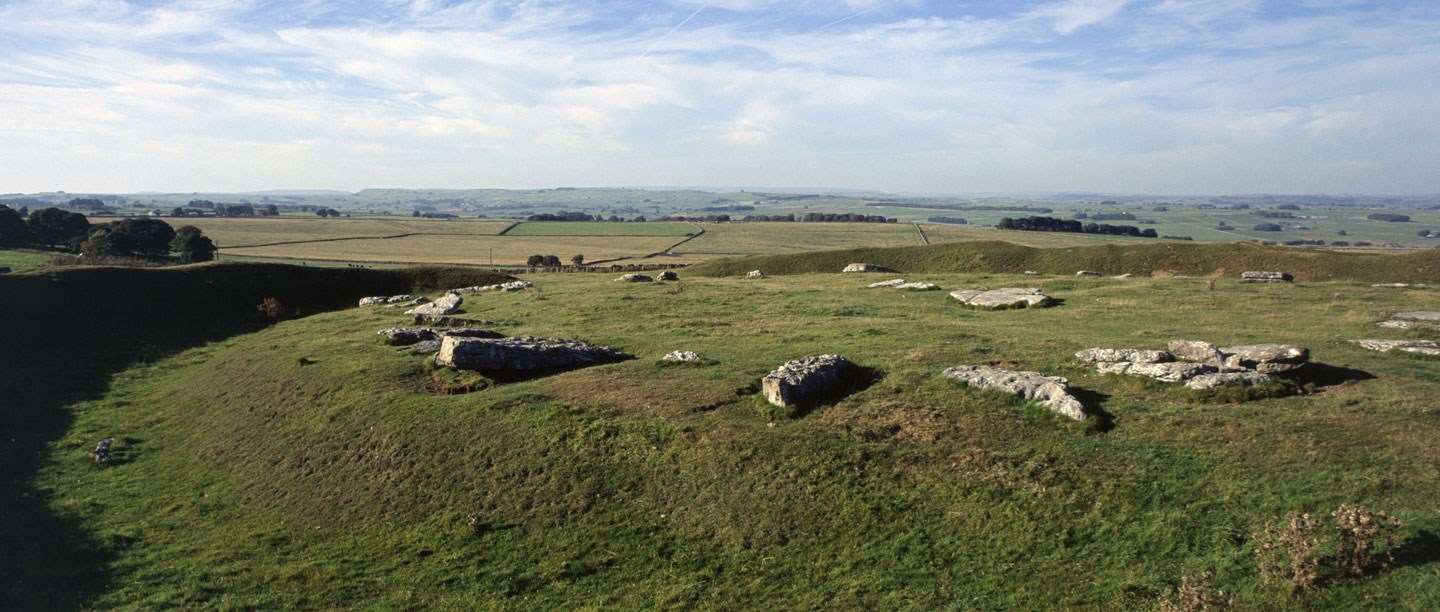
FULL MOON IN CAPRICORN, SUN IN CANCER
JULY 3rd 2023
12 NOON
ARBOR LOW – a circle with exits on the outer bank, seemingly designed to access energies from other directions in the landscape.
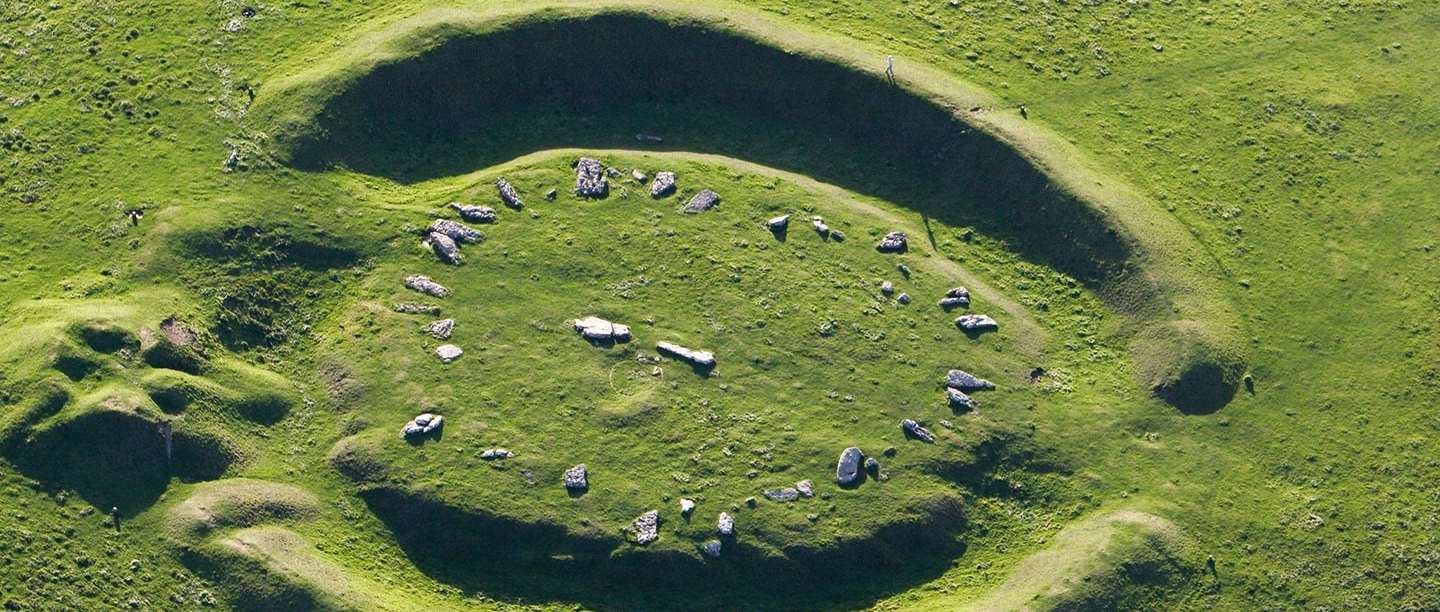
The intention of the ceremonies was to fertilise the land surrounding the settlement and sanctuary. Therefore, perhaps processions would have been enacted through these openings.
Cancer represents the ‘guardian, protector and ‘a lighted house’ – in other words, good, nurturing boundaries for our vision of the future. These boundaries are ‘gateways’ to the wider world, exchanging energy and providing potent environments for initiatory experiences.
The Solar Quest: How do we link our ‘inner guardian’ to our listening to the wisdom of the land? This is a very subtle process and arts in the landscape help us have a creative rapport with the creativity of the spirit of place, a living dialogue. Each sanctuary has a relationship across to other sites, complementing and exchanging energies.
Arbor Low oriented to Robin Hoods Stride and Rowtor Rocks – a wider stage of ritual knowledge and education. Linking across the hills and valleys, the path of the sun and moon gave meaning and connection to scattered communities.
Here are other associated sanctuary sites connected to the circle:
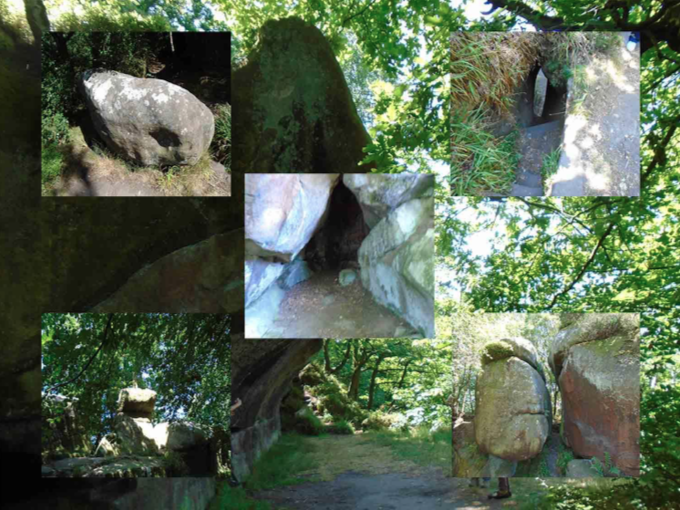
Rowtor Rocks (montage by Charlotte Yonge 2018) with a ‘Druid’s altar’ and caves, which might have provided experiences of inner silence and reflection within an initiatory path through the landscape.
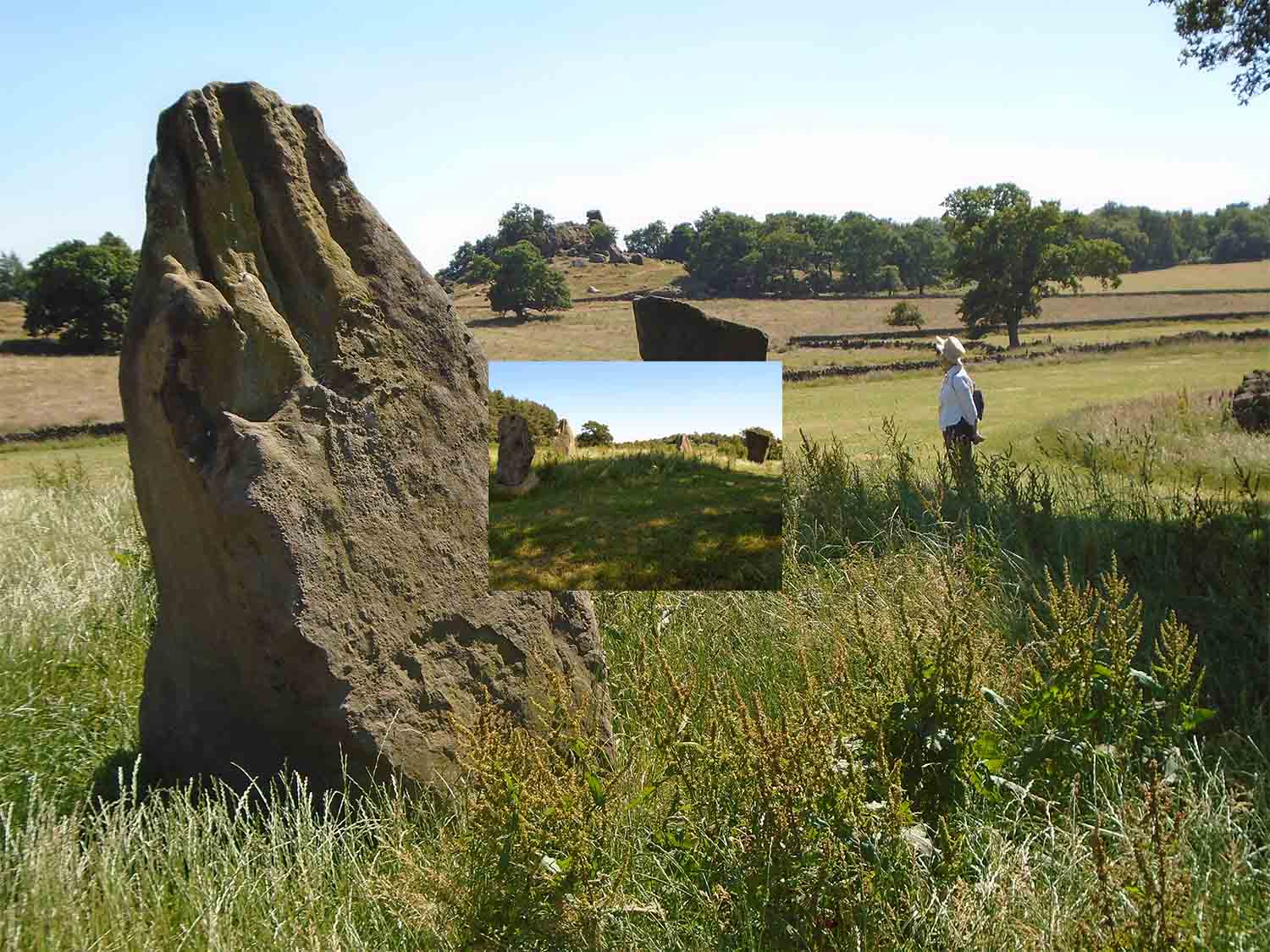
Robin Hood’s Stride – Montage CY 2018) - a range of ‘dragon rocks’ near three standing stones, through which the initiatory path could have been taken, after initial preparation at the sarsens.
How does this teach us about ‘good boundaries’? As we progress through the year, we have given our best imaginative ‘duality blending’ creative attention to our vision of the future. We have brought into our lives a ‘dream team’ (Taurus ‘the builder’, a sign of friendship and equanimity).
In a landscape, sacred monuments orient to different directions according to the rising and setting of the sun and moon, along with other talismanic ‘star clusters’. The patterns of paths and sanctuaries reflect these sky patterns, and especially the Milky Way, symbol of the path of initiation in the alchemical tradition.
The Cancerian ‘ancestor circle’ of Arbor Low links us down the ages to networks of Sanctuaries across Britain. Some of these flowered into a place like the City of London, and many have a direct relationship with our towns and built environment.
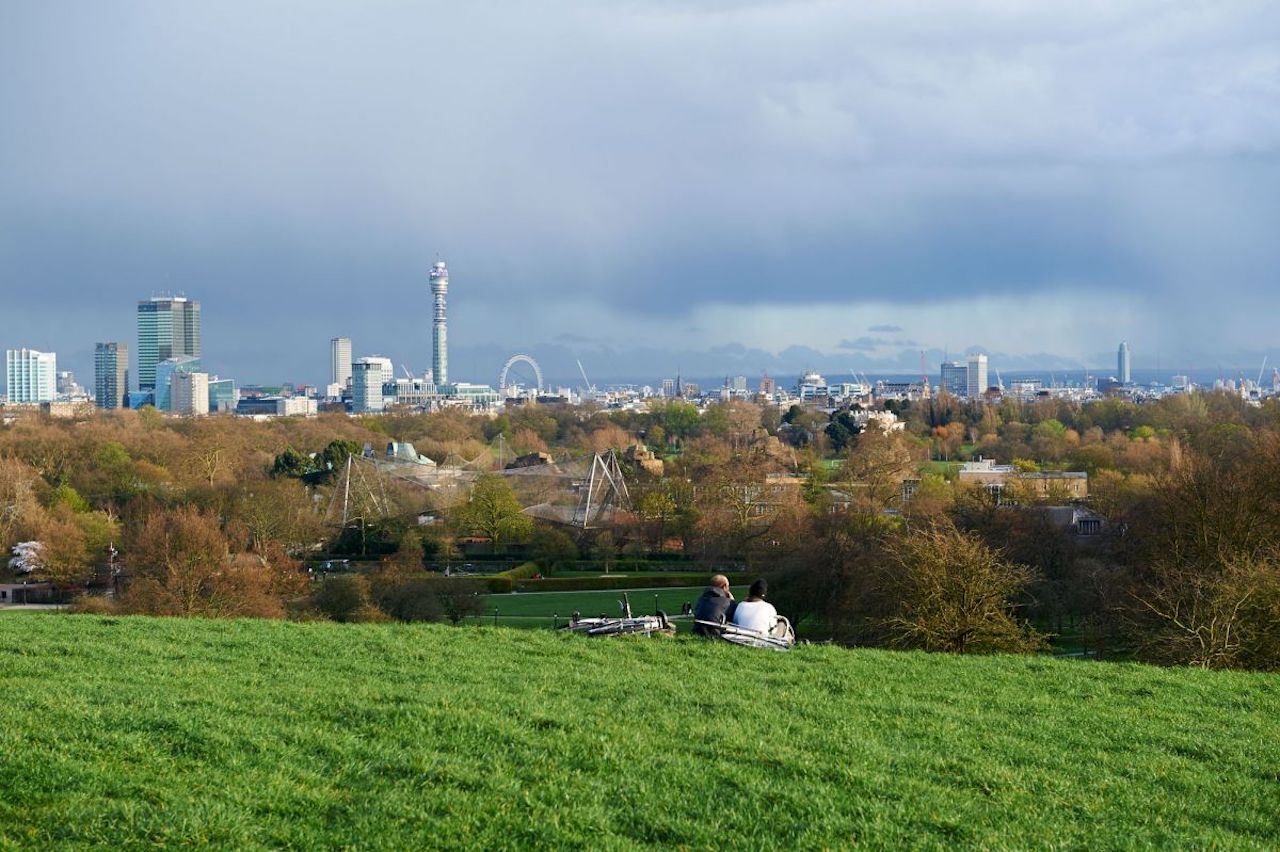
…. And in the ancient capital of Caer Troia/Trinovantium: Primrose Hill
where modern Druids still meet for solstice celebrations…
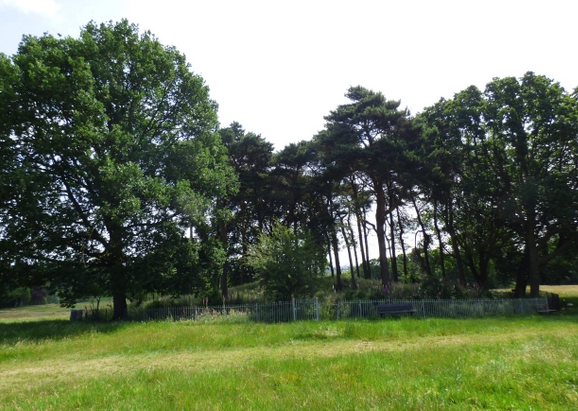
and Boudicca’s Grave… a barrow which might relate to a time earlier than the Romans, attributed to the warrior queen who fought the Romans on many occasions.
CAPRICORN and the ‘responsive’; lunar position to this month’s sun sign:
The sovereignty of King Alfred’s rise to power.
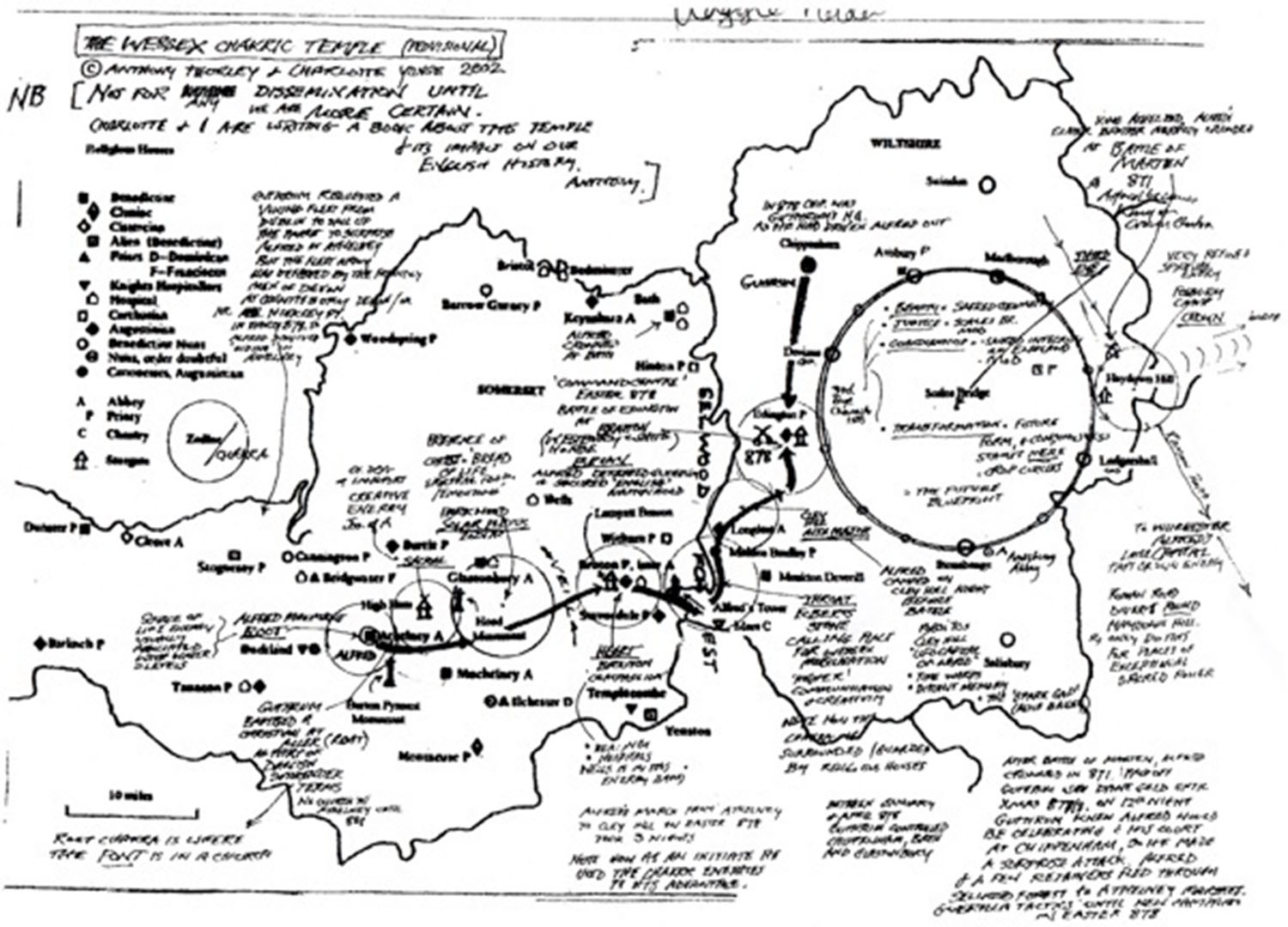
The Wessex terrestrial zodiac, including Glastonbury at the ‘solar plexus’ and the Capricornian zodiac at the ‘third eye’. Alfred’s battle against King Guthrum was at Edington, the ‘alta major’.
In the early 2000’s or thereabouts, a small group met with researcher Anthony Thorley to investigate the apparent symmetry of a circular landscape containing several equidistant cities and sanctuaries: it became known as the Capricorn Zodiac because it revealed the precision and geometry of a 20 mile diameter circle.
Firstly the equidistant features include Stonehenge complex, Durrington Walls, Ludgershall Castle, Marlborough, Merlin’s Mound, Silbury Hill, Avebury complex, Roundway Hill, Devizes, and the East and West Lavington villages. In the centre lies Upavon with ‘Scales Bridge’ and Pewsey Vale. [See Anthony’s Article in ‘Sacred Journeys’ Gatekeeper News No.21]
Anthony spent many hours online, and gathering insights through his enquiring mind. He would phone us up in a state of high excitement when inviting us to tea to hear his latest news.
- All pre-reformation churches within the 20 mile diameter equate to the pattern of star constellations of the Milky Way.
‘The Milky Way, cingulum coeli or girdle of heaven, traverses the gates of heaven at the saltire crossings of the ecliptic pathway of the sun. Beyond this is the deeper Piscean mystery enshrined in the Avebury landscape, of the knot of heaven or nodus celestis, a place which unifies the Goddess and Christ consciousness.’ [Anthony Thorley 2004]
- The eight pre-reformation churches lying within 5 miles of the periphery were dedicated to 8 saints, whose holy days equated with a sign of the zodiac and a ruling planet. There were no spare churches. This created an astrological chart, which proved to accurately represent an astrological birth chart of Bernard of Clairveaux. He was renowned as a leader - as Anthony says ‘the mystical clerics coming over from France to advise the kings and bishops - in the alchemical tradition. Alchemists believed the stars in the firmament represented where Christ and Mary ascended to guide humanity. As the sun crosses the ecliptic at the point of the Milky Way, we find the centre of the galaxy where Christ and Mary reign.
- Each saint of the pre-reformation churches had in their iconography the saltire cross, said to represent the holy sanctuary of the centre of the galaxy within a given landscape zodiac. This was also found to be true of the ‘Milky Way’ route in the Glastonbury Zodiac, discovered by Anthony, who led many pilgrimages along this 10 mile route.
- His investigations revealed a ‘chakric landscape’ within Wiltshire which is symbolic of King Alfred’s journey to sovereignty. Anthony’s walks aim to ‘explore how, throughout history, royal stewardship of the land of Britain meant securing the orb and the sacred rule, or septre, in a timeless Wiltshire geomantic cosmos’. The Capricorn zodiac represents the ‘third eye’ of the landscape temple, with the crown at Haydown Hill. Alfred was crowned in Bath and traveled down a Roman road past Haydown which the road circumnavigated - rare for the Romans. The implication is that in gathering his kingly power, he visited the sanctuaries of ancient times, honouring the traditions and the peoples of those places. He ends up in Winchester to begin his reign.
- The discovery of more accurate alignment associated with this circle includes a ‘ley’ line: ‘Through the 20 mile diameter circle runs a St George line to Wilton (sacred geometry and home of Mary, muse/sponsor of Shakespeare’s works, and centre for Rosicrucianism). It starts at Ogbourne St George, Ogbourne Andrew, Ogbourne Maizey, extends through Merlin’s Mount to Wilton, through Rollstone, through Wilton House. It is seen as St George’s ‘sword of light’ being enacted in the alignment of the churches and the mystic’s interpretation of how Shakespeare’s works came to be written by more than one author. Could it be at the home of Mary Sidney and her brother Phillip who belonged to the ‘Areopagus of Poets’
[see SAT Trustees — Shakespearean Authorship Trust and http://www.marysidneysociety.org/aboutmarysidney: ‘...a woman who developed the most important literary circle in English history, whose mission in life was to create great works in the English language, and who was unable to put her name on work written for the public theater..’
This could be seen as a good example of ‘doing the right thing, at the right time, in the right place’ which Peter Dawkins recommends guards and builds the energy of a sanctuary, as well as the wisdom of a good deed. This evidence of our ancestors of temple protection and tending, involves a constant attendance, heart attunement and trust in human-to-nature dialogue which builds angelic presence or ‘spirit of place’ and nurtures our ability to work with wisdom and beauty.
The Poetic Dialogue of Angels: Wiki: The Areopagus is a proposed 16th-century society or club dedicated to the reformation of English poetry. The club may have involved figures such as Edmund Spenser, Gabriel Harvey, Edward Dyer and Sir Phillip Sidney.’ The house itself contains precise geometric measurements such as a perfect cube. It indicates the significance given by modern esotericists to the way geometry as well as numbers combine in the original sense of ‘mathematical precision’. As King Alfred chose to travel through the sanctuaries of Wessex before being crowned, so the possible authors of Shakespeare’s works may have observed the energy lines and significance of the landscape zodiac, as a place mathematical and geometrical harmony. In other words an inner faith in the landscape’s alchemical ‘grail’ as a birth-place for the wisdom stories and plays of Shakespeare - the ‘spear shakers’..

The ‘spear’ of St George ley, from Ogbourne St George through Merlin’s Mound, Marlborugh, to Wilton House. (after Anthony Thorley’s measurements, 2004)
- Merlin’s Mound in Marlborough College balances with Silbury Hill as being a possible site of a Druidic academy, which Julius Caesar reported as being one of the highly respected places of learning in the country he ‘invaded’, to the point of writing that young Romans were sent to these academies for their education.
- Village names:
- Roundway, a village in the North West of the circle indicates the ‘round’ path of the sanctuary periphery. Roundway Down is also referred to as Oliver’s Castle referring to the Roundhead battle site nearby. Bishop’s Cannings next door is said to lie in the 13th Sign of the zodiac, and lies between the two ends of the Milky Way positioned in the Pewsey Vale.
- Rushall near Upavon, is named significantly with a root word for ‘the apex of a rush covered roof’, which in the pre-Roman age would have beam radiating from a centre point. Does the image of a zodiac come to mind?
- With Anthony, can we believe these symbols of the ‘imaginal world’ to be a place of memory and consistency for the wisdom of the land and our ancestors. These were storied and sung by ‘perpetual choirs’ and bards, whose harmonic voices in the landscape captured the resonnances, and therefore the angellic intelligences’ ‘thoughts of wisdom’ in all their beauty and symmetry.
THE LAND OF OUR ANCESTOR/GUARDIANS:
The laws of Dyfnal Moelmud (Donald the Bald and Still) King of Cornwall
And finally, an ancient source of ‘Good boundaries of law’ for a flourishing culture: The Molmutine Law, root of our Common Law, in turn rooted in the Triads. Wisdom was protected and rooted deeply within Nature.
Dyfnwal Moelmud (Welsh for "Dyfnwal the Bald and Silent" (450-470bc)
His father was Camber, who was the second son of Brutus and Innogen, and a descendant of Aeneas of Troy. Therefore his laws derived from ancient Greek and Trojan roots. They set us a precedent of wisdom in our actions. He was buried under the Temple of Concorde in Trinovantium after the Trinovantes tribe. The city was established by Brutus who called it Troia Nova, or New Troy.
https://www.ldolphin.org/cooper/appen6.html
The following is an account of the law and society as they stood in ancient Britain during the centuries preceding the Roman invasion of 55 BC. It is based upon the surviving laws of king Dyfnal Moel Myd (Dunvallo Molmutius), who reigned in the 5th-4th centuries BC. The account, from pp. 20-24 of Flinders Petrie's paper, (1) bears repeated reading, for it reveals a level of culture and literacy amongst the early Britons that is quite unlike the popular image that has been cultivated in recent years by the modernist treatment of British history. It also speaks volumes for the existence of a king whom modernists have always said was a mythical figure, and it reveals our ancestors to have been a highly cultivated and civilised people, and not the illiterate painted savages of popular fame. … Law was but custom enforced. 'There are three pillars of the law: custom before record and tradition; the king through legal authority; and the decision of the country by vote where there has been neither custom nor law' (155).
https://www.thebernician.net/the-triads-of-the-isle-of-britain-king-dyfnwal-moelmud-36o-bc/
‘Royalty ought to exist in every country in the Isle of Prydein and every royalty ought to be under the protection of the voice of the country. Therefore, it is said “the country is more powerful than a lord.’
Also Natural Life came into the triads - symbolising the way wisdom of Nantre is to be understood and developed:
115. The Three Elder Animals of the Isle of Prydein: The Owl of Cwm Cowlwyd; The Eagle of Gwernabwy; and The Stag of Rhedynvre.
116. The Three Sacred Animals of the Isle of Prudein: The Salmon of Knowledge; The Raven of Rebirth; and the Wild Boar of Truth.
Interpreters and researchers include Flinder Petrie:
https://www.ldolphin.org/cooper/appen6.html
Wiki: ‘One of the Molmutine Laws, according to Geoffrey’s account, declared that the temples of the gods and cities should act as sanctuaries from death. Furthermore, anyone who flees to a temple for being accused of a crime must be pardoned by the accuser upon departure from the temple. This law soon included all roads leading to temples and all farmers were declared safe from such crimes.’
400 BC – This system of Common Law was established in writing by King Dyfnal Moelmud, originally known as the Molmutine Laws, which were applied across Britain for the next two millennia. These laws set in stone the power of the people to nullify miscarriages of justice, unjust laws and tyrannical regimes, by way of what became known as the Grand Jury 1500 years later, but was originally known as a Convention. Britain’s sixty universities, as well as the courts of justice, were presided over by Druids, who extolled the virtue of vicarious atonement and the immortality of the soul, centuries before the birth of Christianity.
The Molmutine Laws are among the texts said to have been "discovered" by the neo-Druid seen as a forger, whose Druidic name was Iolo Morganwg of Glamorgan, written around the year 1800. They are given in the form of triads and include:
- There are three tests of civil liberty: equality of rights, equality of taxation, freedom to come and go.
- Three things are indispensable to a true union of nations: sameness of laws, rights, and language.
- There are three things free to all Britons: the forest, the unworked mine, the right of hunting.
- There are three property birthrights of every Briton: five British acres of land for a home, the right of suffrage in the enacting of the laws, the male at twenty-one, the female on her marriage.
- There are three things which every Briton may legally be compelled to attend: the worship of God, military service, the courts of law.
- There are three things free to every man, Briton or foreigner, the refusal of which no law will justify: water from spring, river, or well; firing from a decayed tree; a block of stone not in use.
- There are three classes which are exempt from bearing arms: bards, judges, graduates in law or religion. These represent God and His peace, and no weapon must ever be found in their hands.
- There are three persons who have a right of public maintenance: the old, the babe, the foreigner who can not speak the British tongue.
- There are three things free to a country and its borders: the roads, the rivers, and the places of worship. These are under the protection of God and His peace
King Alfred’s Anglo Saxon Law contained an interesting updates as a product of his wisdom, on the Molmutine system:
[https://www.bbc.co.uk/bitesize/topics/z8w3n9q/articles/zxhqkty]
- There wasn't a police force like we have today. Keeping law and order was the responsibility of everyone in the village.
- If someone was seen committing a crime then the witness could raise a hue and cry (shouting for help). Everyone who heard it was expected to help chase and capture the suspects.
- There was a system in place called Tithing in which a group of ten men were made responsible for each other’s behaviour. If one of them broke the law, the other members of the tithing had to bring them to court. If they didn't, they would have to pay a fine.
- Every male over the age of twelve was expected to join a tithing.
Wheel of Life as a ‘memory device’
‘It is important to realise that the Wheel of Life or Zodiac is essentially archetypal. That is to say, it exists in its original as a divine or spiritual thought-form. To this is added the knowledge concerning the Wheel that has been acquired over the millennia of human evolution, together with a language to convey that knowledge, thereby superimposing a human thought-form upon the divine archetype. The divine archetype manifests everywhere, in every form of life, not just in the heavens; but it is in the sky that we are generally first made aware of it. The association of stars and constellations with the fundamental imagery of the Zodiac is almost purely a memory device, so that we can remember and pass on to others the pattern, symbolism and meaning of the Wheel of Life, together with its relationship to time and space and the evolutionary life process. [Peter Dawkins: https://www.zoence.co.uk/time-cycles/zodiac-ages/]
We can ponder whether the reason that the ‘Welsh Triads’ were not written down, was because they needed to be sung by the three PERPETUAL CHOIRS, as a means of endorsing and embedding the wisdom of the land within memory. Harmonics of the human voice may have embedded into muscle memory of both the singers and listeners. These musical notes would also include some interesting geometry and mathematical measurement, as a poetic philosophy of received landscape wisdom. How did these choirs keep singing perpetually?
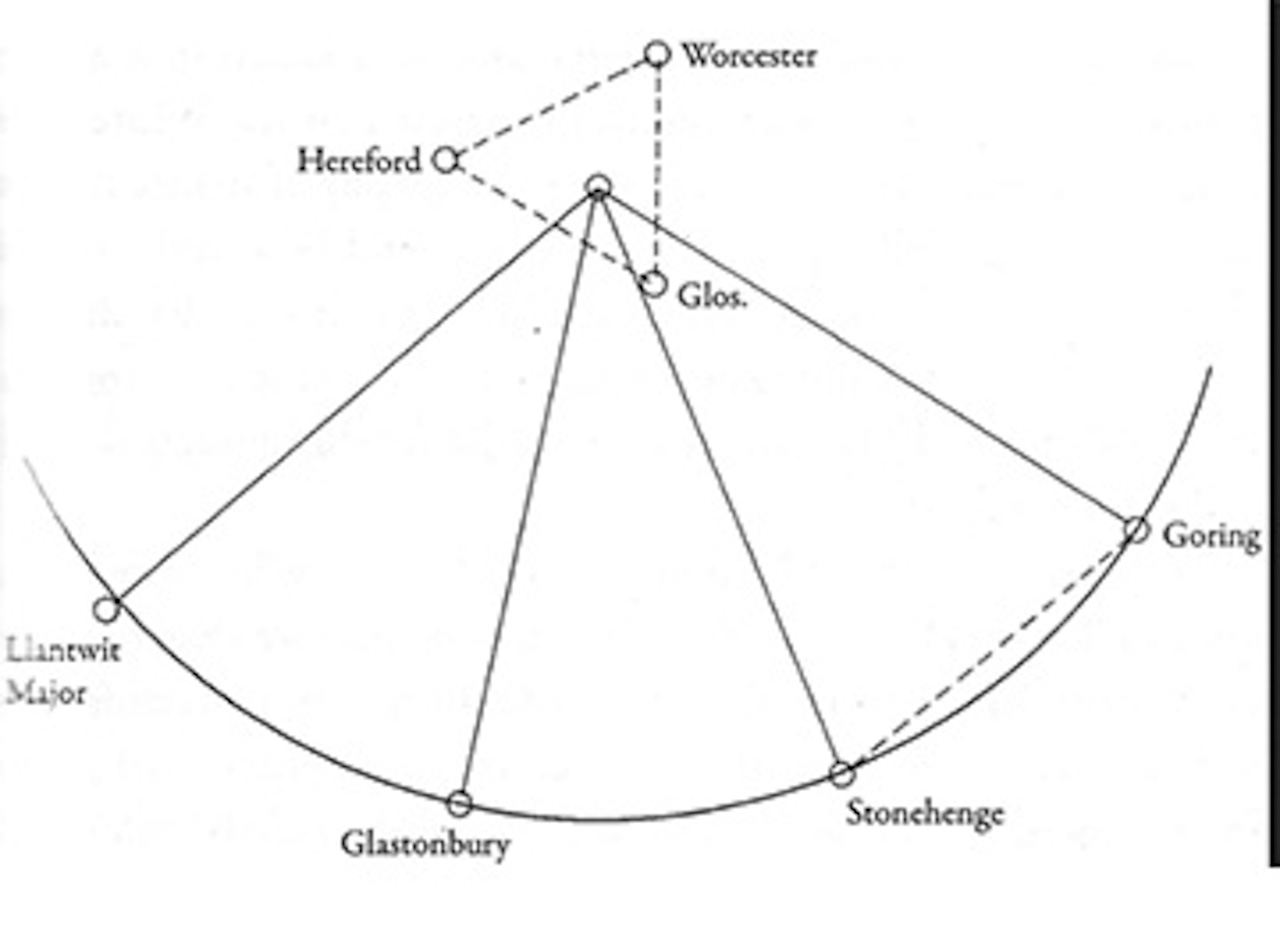
(Ref: ‘Measure of Albion: The Lost Science of Prehistoric Britain’ 2004 by Robin Heath; John Michell)
Remembering the Numinous and imaginal world:
C G Jung believed man’s symbols were living and directing human development on earth and were derived from the ‘numinous’ dimension. ‘‘We might say that the term ‘religion’ designates the attitude peculiar to a consciousness which has been changed by experience of the numinosum….The stone symbolized something permanent that can never be lost or dissolved, something eternal that men have compared to the mystical experience of god within one’s soul.’ [quoted by Anthony Thorley in a talk to pilgrims about the ‘imaginal world’ in South Devon, 2003)
Numinosum (Latin) - "arousing spiritual or religious emotion; mysterious or awe-inspiring’ (Wikipedia).
JUNG: ‘The stone symbolized something permanent that can never be lost or dissolved, something eternal that men have compared to the mystical experience of god within one’s soul.’
GUARDIANS OF THE NUMINOUS AND IMAGINAL WORLDS:
As guardians of landscape sanctuaries and temples, we as Gatekeepers can recreate ‘safe places’ in today’s world, through listening to the subtle intelligence of Nature around us, learn wise ways as new groups of ‘experienced elders’, as well as the honour angelic presences inhabiting buildings and places we know well, thus enhancing their positive effect on those opening their hearts to creative change, beauty and harmony. Our energy sciences confirm the existence of fields of energy, and ways of tapping electricity. These are only a resonance away from the theory of earth energy, how it accumulates and its relationship to human creativity.
In our ‘wheel of life’ landscape designs, we find the truths of the star maps as ‘memory devices’… designed to maintain the historical achievements of wisdom-guardianship of our ancestors. Thus we are keeping alive the heart wisdom, all that’s best in our Humanity, when we pilgrimage through our ancestor’s sanctuaries,where reside the great records of knowledge, wisdom and measurement.
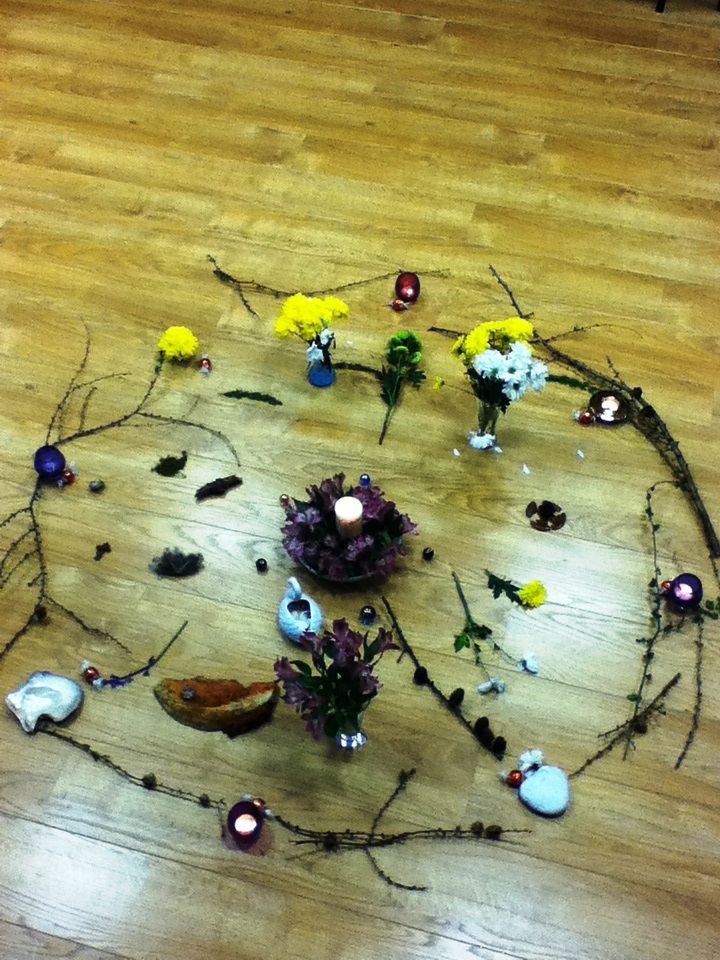
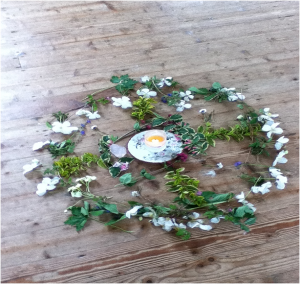
Art in the landscape and circle dancing on the Isle of Man
– recreating the wheel of life - ‘mandala-art’ as a memory of grail space shared together, and memory of the subtle inspiration of spirit of place.
[Charlotte Yonge and pilgrim group 2014)
Editors: Charlotte Yonge, Rose Williams, and Sarah Dawkins 2023.